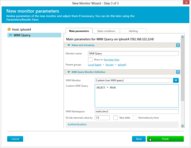With IPHost Network Monitor you can run WMI Page Reads Persec monitoring of various devices in your network.
To create a WMI monitor for Page Reads Persec, provide host name (it must be a Windows host) and specify custom WQL query:

Page Reads/sec is the rate at which the disk was read to resolve hard page faults. It shows the number of reads operations, without regard to the number of pages retrieved in each operation. Hard page faults occur when a process references a page in virtual memory that is not in working set or elsewhere in physical memory, and must be retrieved from disk. This counter is a primary indicator of the kinds of faults that cause system-wide delays. It includes read operations to satisfy faults in the file system cache (usually requested by applications) and in non-cached mapped memory files. Compare the value of Memory\\Pages Reads/sec to the value of Memory\\Pages Input/sec to determine the average number of pages read during each operation.
The Memory performance object consists of counters that describe the behavior of physical and virtual memory on the computer. Physical memory is the amount of random access memory on the computer. Virtual memory consists of the space in physical memory and on disk. Many of the memory counters monitor paging, which is the movement of pages of code and data between disk and physical memory. Excessive paging, a symptom of a memory shortage, can cause delays which interfere with all system processes.
IPHost Network Monitor is an advanced and easy tool for monitoring LAN and WAN networks, network servers, workstations and TCP/IP devices. Use IPHost Network Monitor to monitor your servers, domains, computers and devices.

